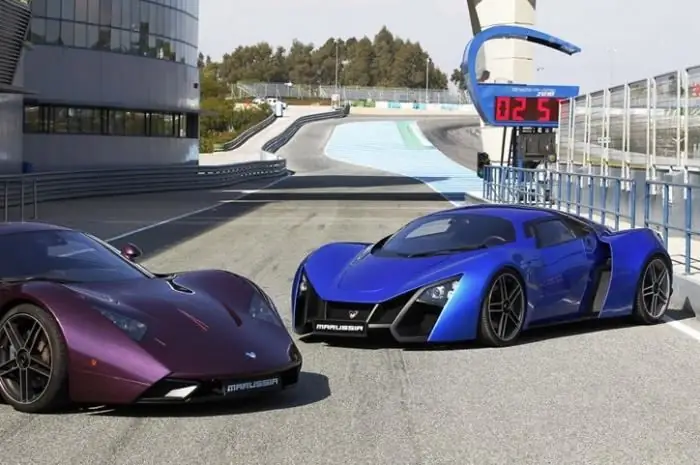2025 Author: Erin Ralphs | [email protected]. Last modified: 2025-01-22 21:14:11
Even if you are far from the automotive world, you are still aware that each automaker has its own emblem that adorns the radiators of cars coming off its assembly lines. This is not just a picture-difference, but a symbol that has its own meaning and sometimes quite a fascinating story. In this spirit, we invite you to take a closer look at the Volvo logo, which is already over 80 years old.
How Volvo started…
What does the word "Volvo" even mean? This name, easy to pronounce and remember by most native speakers of world languages, was proposed by one of the members of the board of the concern. The root of the word is the Latin verb volvere ("to ride", "to roll"). Hence Volvo - "I'm rolling", "I'm driving".

The company itself was founded in 1915 by G. Larson and A. Gabrielsson. Its original name was not entirely harmonious - Svenska Kullagerfabriken (SKF). It should be noted that the company began its activities with the production of bearings, gas burners, bicycles, caravans and even office chairs.
But the first car, named "Jakob", rolled off the assembly lines of Svenska Kullagerfabrikenonly in 1927.
Volvo logo
The development of the concern's emblem is also associated with the release of the first car. It is based on the ancient symbol of iron, the sign of the god of war Mars, a recognizable image of the masculine principle. The Volvo logo is the embodiment of strength, invincibility, speed. This seemingly simple circle with an arrow pointing upwards has not lost its relevance for 80 years! Today it is still an iconic part of the design of the Volvo car line.
This symbol was not chosen by the designers by chance - it is one of the most recognizable and understandable in Western (Scandinavian, Vedic, Aryan, Celtic) culture. And the reference to the invincible god Mars (according to legend, he fought using only iron weapons) is interpreted in different positive senses:
- Volvo Concern is associated with cutting-edge achievements in the modern steel industry (the ancient symbol of iron).
- Mars invincibility=reliability, durability, high quality car.
- The sign of the embodiment of strength, masculinity, striving for victory, new horizons also favorably emphasizes the status of the car owner with the Volvo logo.

From the history of the emblem
Besides the symbol of Mars, Volvo has one more emblem, which was formed, as they say, "by itself".
Its history is connected with the first car. To make it more convenient to attach the Volvo logo to the radiator, it was decidedwas to make a diagonal strip on its lattice. It continued from the lower left corner to the upper right. After a while, many began to define this auxiliary element as part of the company logo.
Over time, they did not remove it, although the need for a strip had already disappeared. Why, if it has become recognizable by the audience? You can see such a strip on modern Volvo cars. However, today it carries only a decorative mission.
In 1958, the auto concern developed its own unique font for writing the name on the logo. It must be said that it was chosen so well that it has reached our days with only minor modifications.
Volvo today
Since there was no single standard for car emblems for a long time, the Volvo nameplate went through a redesign process several times. In the photo of the Volvo logos, you yourself can trace its modifications.
What about today? In modern times, the Volvo badge is the same diagonal strip, the ancient sign of strength and the god of war Mars, as well as the Volvo inscription, made in a 1958 typeface.

As we have seen, the logo of the well-known car concern "Volvo" is one of the examples of the most successful choice of emblem design. It is recognizable, understandable and significant both eighty years ago and today. And it is surprising that "His Majesty Chance" helped to diversify it, as often happens.
Recommended:
"Volvo C60": owner reviews, description, specifications, advantages and disadvantages. Volvo S60

Volvo is a Swedish premium brand. This article will focus on the 2018 Volvo S60 (sedan body). A brand new car of this model with 249 horsepower will cost you more than one and a half million Russian rubles. This is much more expensive than the average class of cars in the Russian Federation, but much cheaper than no less prestigious German counterparts. However, this article will focus specifically on the Volvo S60 2018
Rating of active foam for car washing. Foam for washing the car "Karcher": reviews, instructions, composition. Do-it-yourself car wash foam

It has long been known that it is impossible to clean a car from heavy dirt with plain water. No matter how hard you try, you still can't achieve the desired purity. In order to remove dirt from hard-to-reach places, special chemical compounds are used to reduce surface activity. However, they also cannot reach very small cracks and corners
Car "Marusya" - the first domestic sports car in the history of the Russian car industry

The Marusya sports car dates back to 2007. It was then that VAZ was offered the idea of creating the first racing car in Russia
Volvo P1800: everything you need to know about the Swedish sports car of the 60s

Volvo P1800 is an amazing car. It is considered aesthetically appealing and powerful even today, despite the fact that its production was carried out in the 60s. In total, about 47,000 copies were produced. So this car is a real rarity and exclusive. And that is why I would like to talk about it in more detail
How to “light up” a car from a car? How to “light up” an injection car?

Probably every driver has faced such a problem as a dead battery. This is especially true in winter cold. In this case, the problem is most often solved by "lighting up" from another car

